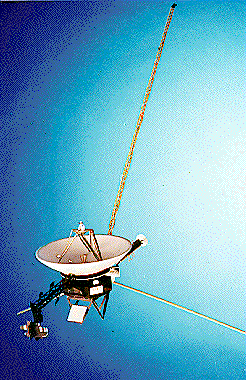Full View of an Assembled Voyager
Space Craft SCIENCE Kit

Here's a full view of an assembled Voyager Space Craft SCIENCE Kit, showing the full length of the magnetometer boom. On the spacecraft, this 13-meter long boom, made of fiberglass, holds two sensitive instruments (magnetometers) out away from the spacecraft. This way, the instruments can measure the magnetic fields in the vicinity of planets, without much interference from magnetic fields aboard the spacecraft itself.
On the model, the boom is made of very intricately laser-cut trusswork -- 180 small interconnected rectanges, each containing X-shaped trusswork, to closely mimic the spacecraft's boom. The boom assembly comes as two pieces in the model to fold and glue. The assembled model's boom can support itself nicely, something the spacecraft's boom could not do while it was in Earth's gravity. The kit's assembly instructions offer the choice of assembling it with only half the boom's length, in case you prefer not to deal with the delicate appendage. In high humidity environments, the full-length boom may wilt over time, although the model can be oriented to minimize the possibility of this happening (it's discussed in the instructions).
This photo also shows the two Planetary Radio Astronomy antennas extending away from the spacecraft at right angles to the magnetometer boom. On the spacecraft, they receive radio emissions from planets. The same antennas are also used by the Plasma Wave experiment. These, and all the other instruments, are described in the material that comes with the kit.
The square component near the bottom of the spacecraft in this view is the target plate, which is used on the spacecraft for calibration of the cameras - it's a neutral grey color. It also supports the shunt regulator for the spacecraft's elecrical system. This generates heat in the target plate, so it can also be used to calibrate the infrared instrument.
The assembled Voyager model measures 22 inches (55 cm) from the tip of the magnetometer boom to the end of the science boom (where the cameras and other pointable optical instruments are located) on the opposite side of the spacecraft.
| SCI HOME PAGE | CATALOG | HOW TO ORDER | GREAT SPACE LINKS |